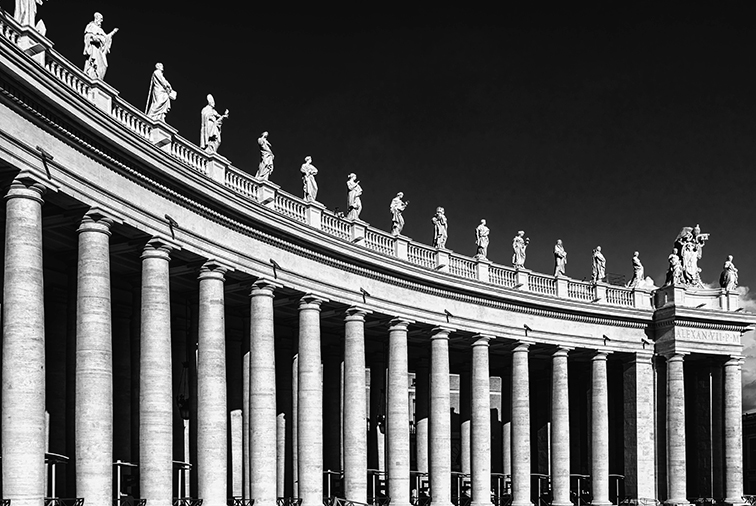The Jubilee originates from the Jewish tradition that, every 50 years, designated a year of rest for the land—a special year of forgiveness and repentance during which sins were forgiven, slaves were freed, and debts were canceled.
The term “Jubilee” derives from the Hebrew yobel, meaning “ram,” as in ancient Israel, the sound of a ram’s horn marked the beginning of the Holy Year.
The first Jubilee of the Church was introduced by Pope Boniface VIII in 1300 with the papal bull Antiquorum habet fida relatio. This bull granted plenary indulgence to all who, during that calendar year, visited the Basilicas of St. Peter and St. Paul Outside the Walls thirty times if they were Roman citizens or fifteen times if they were foreigners.
In over 700 years of history, the Jubilee was delayed only once. This was for the 1600 Jubilee when Pope Clement VIII was unable to attend the opening of the Holy Year. The Jubilee’s start was postponed by one week, moving from December 24 to December 31. The Pope’s absence, however, had no “mystical” reason—it was due to a sudden attack of gout. Clement VIII, born Ippolito Aldobrandini, continued his papacy for 13 more years until his death. The 1600 Jubilee is also remembered for a historic event: the execution of Giordano Bruno in Campo de’ Fiori. The former Dominican friar from Nola was burned at the stake, accused by the Roman Inquisition of heresy. He was charged with defying the sacred dogmas of Catholicism and deliberately seeking martyrdom, dismissing physical suffering and asserting that his soul would reunite with the universe. Bruno’s execution exemplified the repressive climate of the Holy Inquisition, which sought to safeguard ecclesiastical power by suppressing disruptive ideas and controlling scientific inquiry.
The Jubilee, however, did not eradicate certain peculiar vices among the clergy. For instance, smoking tobacco inside churches became a widespread practice among Vatican priests.
The Jubilee has also faced devastating epidemics. One of the most dramatic instances occurred during the Jubilee of 1350, which was overshadowed by the Black Death. Originating in northern China and spreading to Europe via Syria, Turkey, and Greece, the plague mysteriously disappeared around 1353, but not before killing at least one-third of Europe’s population. From that year onward, only those with a valid health certificate, proving the absence of plague in their area of residence, were allowed to participate in the Jubilee in Rome.
Pope Alexander VI Borgia, in 1500, established the rigid ceremonial framework of the Jubilee, which has remained largely unchanged. That year also saw the construction of the so-called Via Alessandrina, linking St. Peter’s Basilica to Castel Sant’Angelo, achieved by demolishing the medieval district of Borgo. The Holy Year begins with the Pope passing through the Holy Door, holding a cross in his right hand and a lit candle in his left. The same ceremony is performed by cardinals at the other three basilicas. The Holy Year concludes with the Holy Doors being bricked up until the next Jubilee.
The life of Michelangelo Buonarroti, one of the greatest figures of the Italian Renaissance, is intertwined with Jubilee years. In 1499, Michelangelo completed the famous Pietà, which was displayed at the entrance of St. Peter’s Basilica for the 1500 Jubilee celebrations. In 1525, during the ninth Jubilee, the Sistine Chapel frescoes were completed, and in 1550, the extraordinary Last Judgment was unveiled to the world.
According to various literary interpretations, Dante’s imaginary seven-day journey through Hell, Purgatory, and Paradise took place during the Easter period of the first Jubilee of 1300, specifically on Good Friday, April 8. Dante’s literary “wandering in the dark forest” is set at the midpoint of his life, approximately at age 35. Since Dante was born in 1265, the year 1300 aligns perfectly. In The Divine Comedy, Canto XVIII of Inferno, Dante describes the event:
“The sinners were naked in the valley;
from the middle they came towards our faces,
on one side with us, but with larger steps,
as the Romans, during their vast crowds,
in the Jubilee year, organized their ways,
one side facing the castle, heading to St. Peter’s,
the other towards the mountain on the other shore.”
In 1800, the Jubilee was tied to political upheavals in Italy and Europe. At the start of the 19th century, the Jubilee was not proclaimed, as Pope Pius VI had been imprisoned in France, where he died in exile in 1799. His successor, Pius VII, had not yet assumed office.
Similarly, the Jubilee was not celebrated in 1850. Pope Pius IX was not in Rome at the time, returning to the city only on April 12, 1850, with the support of French forces after the Roman Republic period.
In 1875, the Jubilee was announced but not held, as in 1870, Rome had become part of the Kingdom of Italy and its capital in 1871. Pope Pius IX voluntarily confined himself to the Vatican.
The Jubilee of 2000 held special significance as it celebrated two millennia since the birth of Christ and was the first Jubilee spanning two millennia.
Over the centuries, the Jubilee has also had a significant impact on tourism. The phrase “the Romans all became innkeepers” highlights the business opportunities created by the influx of pilgrims. Thousands arrived in Rome, seeking accommodations and meals from the locals. This gave rise to the saying that Romans transformed into innkeepers, capitalizing on the natural economic boom generated by the extraordinary flow of pilgrims.
Another notable aspect is the dual nature of the event: ordinary and extraordinary. An ordinary Jubilee occurs at regular intervals (every 25 years), while an extraordinary Jubilee is proclaimed at the Pope’s discretion.
For the 2025 Holy Year, the Holy Door at St. Peter’s Basilica will open on December 24, 2024. The other three Holy Doors in Rome will open on December 29, 2024, at St. John Lateran (the Pope’s cathedral); on January 1, 2025, at St. Mary Major; and finally, on Sunday, January 5, at St. Paul Outside the Walls.








